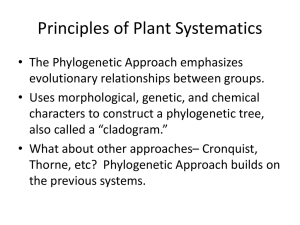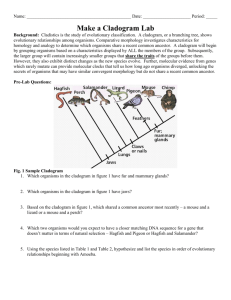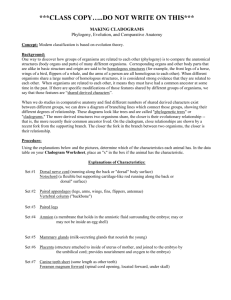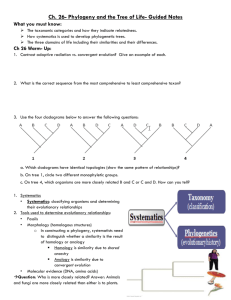How to Build a Cladogram
advertisement
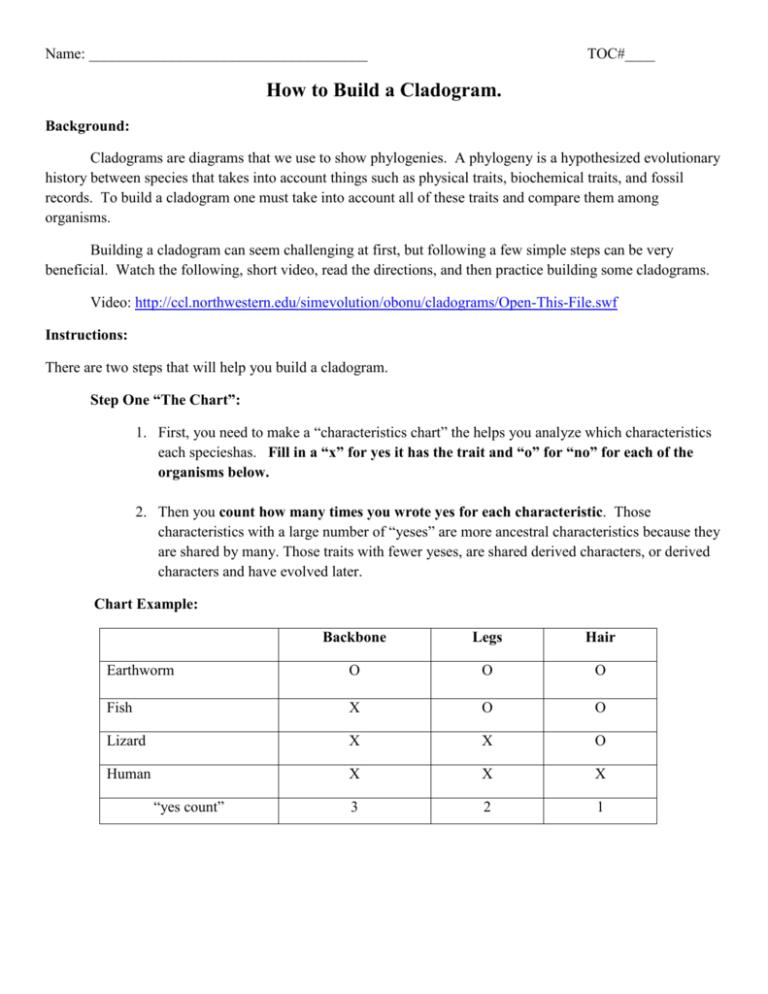
Name: _____________________________________ TOC#____ How to Build a Cladogram. Background: Cladograms are diagrams that we use to show phylogenies. A phylogeny is a hypothesized evolutionary history between species that takes into account things such as physical traits, biochemical traits, and fossil records. To build a cladogram one must take into account all of these traits and compare them among organisms. Building a cladogram can seem challenging at first, but following a few simple steps can be very beneficial. Watch the following, short video, read the directions, and then practice building some cladograms. Video: http://ccl.northwestern.edu/simevolution/obonu/cladograms/Open-This-File.swf Instructions: There are two steps that will help you build a cladogram. Step One “The Chart”: 1. First, you need to make a “characteristics chart” the helps you analyze which characteristics each specieshas. Fill in a “x” for yes it has the trait and “o” for “no” for each of the organisms below. 2. Then you count how many times you wrote yes for each characteristic. Those characteristics with a large number of “yeses” are more ancestral characteristics because they are shared by many. Those traits with fewer yeses, are shared derived characters, or derived characters and have evolved later. Chart Example: Backbone Legs Hair Earthworm O O O Fish X O O Lizard X X O Human X X X 3 2 1 “yes count” Step Two “The Venn Diagram”: This step will help you to learn to build Cladograms, but once you figure it out, you may not always need to do this step. 1. Draw a multi-cicular Venn diagram. You will need as many circles as there are characters. 2. Start with the character that is shared by all the taxa on the outside. (you will want to make this a large circle.) 3. Inside each box, write the species that have only that set of characters. 4. On the outside of the Venn Diagram, write the outgroup. This is a group of organisms that do not share any traits and serve as a comparison to the phylogeny you are looking at. Hair: human Legs: lizard Backbone: fish Outgroup: Earthworm Step Three “The Cladogram”: This step converts the Venn Diagram into a cladogram. The traits are written on the main line, and species go on the branches. On the cladogram below, try to put all the characters and the species in the correct evolutionary history. Interpreting a Cladogram First, let’s practice interpreting some cladograms. Looking at the images, answer the questions below 1. Which species is the outgroup? 2. After which animals did mammary glands develop? 3. What animal does not have jaws? 4. Which animals have lungs? 5. What other animals would come after the chimp? 6. What could the character trait be that would come after the chimp? 7. What character trait separates salamanders and lizards? 8. List at least one shared derived character and explain who it is shared by. 9. List at least one derived character and explain why. 10. Based on the cladogram, which shared a common ancestor most recently- a mouse and a lizard, or a mouse and a perch? 11. What evolutionary event occurs when a species branches off from the main line? Building a Cladogram 1. Fill in the following table. Mark an X if the species has the trait and O if they do not Hair Legs Thumbs eyes Human Snake Monkey Mouse Starfish 2. Draw a Venn diagram 3. Draw a cladogram with all species and character traits. 4. Using complete sentences, explain why you put each species where you did. 5. According to your cladogram, which two species are more closely related: humans and snakes or humans and mice? How do you know? 6. According to your Diagram, what species are humans most closely related to? How do you know? 1. Fill in the following table. Mark an X if the species has the trait and O if they do not Hair Legs Thumbs eyes Worm Spider Ant Fly bacteria 2. Draw a Venn diagram 3. Draw a cladogram with all species and character traits. 4. Using complete sentences, explain why you put each species where you did. 5. According to your cladogram, which two species are more closely related: worms and spiders or worms and ants? How do you know? 6. According to your cladogram, what species are flies most closely related to? How do you know? Name: _____________________________________ TOC#_____ Invertebrate Cladogram Background: During this unit, we are discussing how to classify and categorize organisms based on evolutionary change. Cladograms are a major way in which scientists do this. By this time you should have a good understanding of how to construct a cladogram by looking at a couple of species at a time. However, the most important part of building a cladogram is that it helps scientists see the evolutionary relationship over long periods of time, show many steps. Throughout our unit we will be focusing on how Vertebrates have evolved over time. However, we will start by taking a quick look and invertebrates to see how that evolution led to the evolution of vertebrate animals. Instructions: Using the chart below, create a Venn Diagram of the species. Then, on the back, create a cladogram of how these species may be related evolutionarily. It is ok if you do not know what all the characteristics are. We will discuss them. Character Cells with flagella Body Symmetry Bilateral Symmetry Mesoderm Head Develops first Anus develops first Segmented body Calcified Shell Chitonous Exoskeleton Water vascular system Vertebrae Venn Diagram: Sponge X Jellyfish X X Flatworm Earthworm Snail X X X X X X X X X X X X X X Fuitfly Starfish Human X X X X X X X (X) X X X X X X X X X X X X




